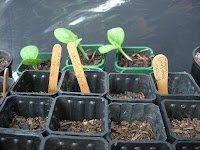
 I'm trying a three sisters bed of corn modified to suit with some climbing cucumbers at the outside edge of each row. They will climb up the sweet corn plants and the bed will give you a double harvest.
I'm trying a three sisters bed of corn modified to suit with some climbing cucumbers at the outside edge of each row. They will climb up the sweet corn plants and the bed will give you a double harvest.
 I'm trying a three sisters bed of corn modified to suit with some climbing cucumbers at the outside edge of each row. They will climb up the sweet corn plants and the bed will give you a double harvest.
I'm trying a three sisters bed of corn modified to suit with some climbing cucumbers at the outside edge of each row. They will climb up the sweet corn plants and the bed will give you a double harvest.Why did my seeds not come up?
Seedlings may not have emerged from the potting mix or from the soil for these reasons:
 Planting a Three Sisters Garden
Planting a Three Sisters Garden




 Amongst the emerging blossoms and a whole Lotta vegetables we all enjoyed our August meeting and International Kitchen garden day. Despite our little deviation towards Echuca we arrived and the Sun was shining, a beautiful nearly spring day.
Amongst the emerging blossoms and a whole Lotta vegetables we all enjoyed our August meeting and International Kitchen garden day. Despite our little deviation towards Echuca we arrived and the Sun was shining, a beautiful nearly spring day.



 Cabbage, if your like me you always grow more than what your can use and think we all have memories of someone overcooking it to a grey mash, The notorious odor problem is a result of over cooking. and as a result, we don't use this wonderful veg.
Cabbage, if your like me you always grow more than what your can use and think we all have memories of someone overcooking it to a grey mash, The notorious odor problem is a result of over cooking. and as a result, we don't use this wonderful veg.

The berry patch - Think about how and when you will be picking each crop before you plant. Strawberries ripen daily (and grow low to the ground), so it's important they be reachable from the path. 
Guilt-free snipping -Cutting flowers, like these assorted dahlias, are traditionally grown in rows like vegetables. That way, you don't feel like you are spoiling a garden composition every time you gather some. decorative herbs A row of flowering herbs like lavender provides fragrant ornamentation and can be harvested late in the season to dry for the house.
decorative herbs A row of flowering herbs like lavender provides fragrant ornamentation and can be harvested late in the season to dry for the house.
Herb is the word - useful herbs mix up this area with mass plantings of several kinds of herbs. Some annual types such as basil and cilantro will go to seed quickly in hot weather, so include perennials like rosemary, sage and thyme.
Themes and variations - formally designed beds can be symmetrical without being mirror images. Contrast the yellow 'Russian Giant' sunflowers at upper left with a row of dark-brown 'Velvet Queen' sunflowers here.
morning glories, meet garlic. Highs and lows add some height Towering plants like these 'Russian Giant' sunflowers create a living fence. The rows of flowers will make an attractive see-through screen
All-season structure Nonbotanical elements like obelisks have an appealing formality and give composition to the beds early in the season, when seedlings are small.
not just mixed greens Introduce extra color by planting varieties with unusual-hued leaves like dark 'Red Sails' or frilly 'Lolla Rossa' lettuce.
 Look at some of these wonderful veggie plots, I only wish I could re-start mine. The keyhole example would definitely suit small yards as would the yin/yang round bed. As for the weaving, it just goes to show that you can have a beautiful creative garden and a productive one too! do as the lady with the little star garden is and Enjoy
Look at some of these wonderful veggie plots, I only wish I could re-start mine. The keyhole example would definitely suit small yards as would the yin/yang round bed. As for the weaving, it just goes to show that you can have a beautiful creative garden and a productive one too! do as the lady with the little star garden is and Enjoy 





